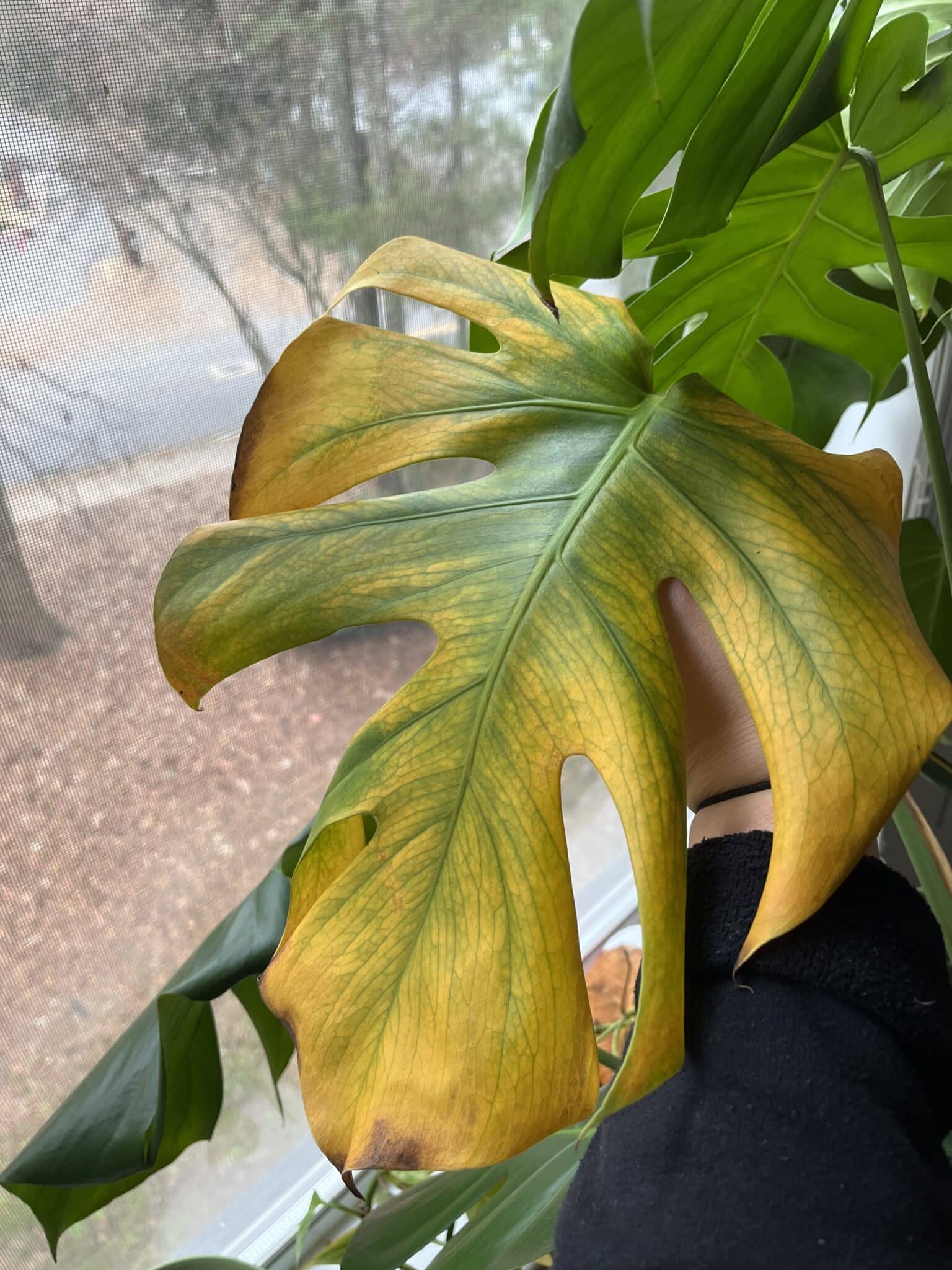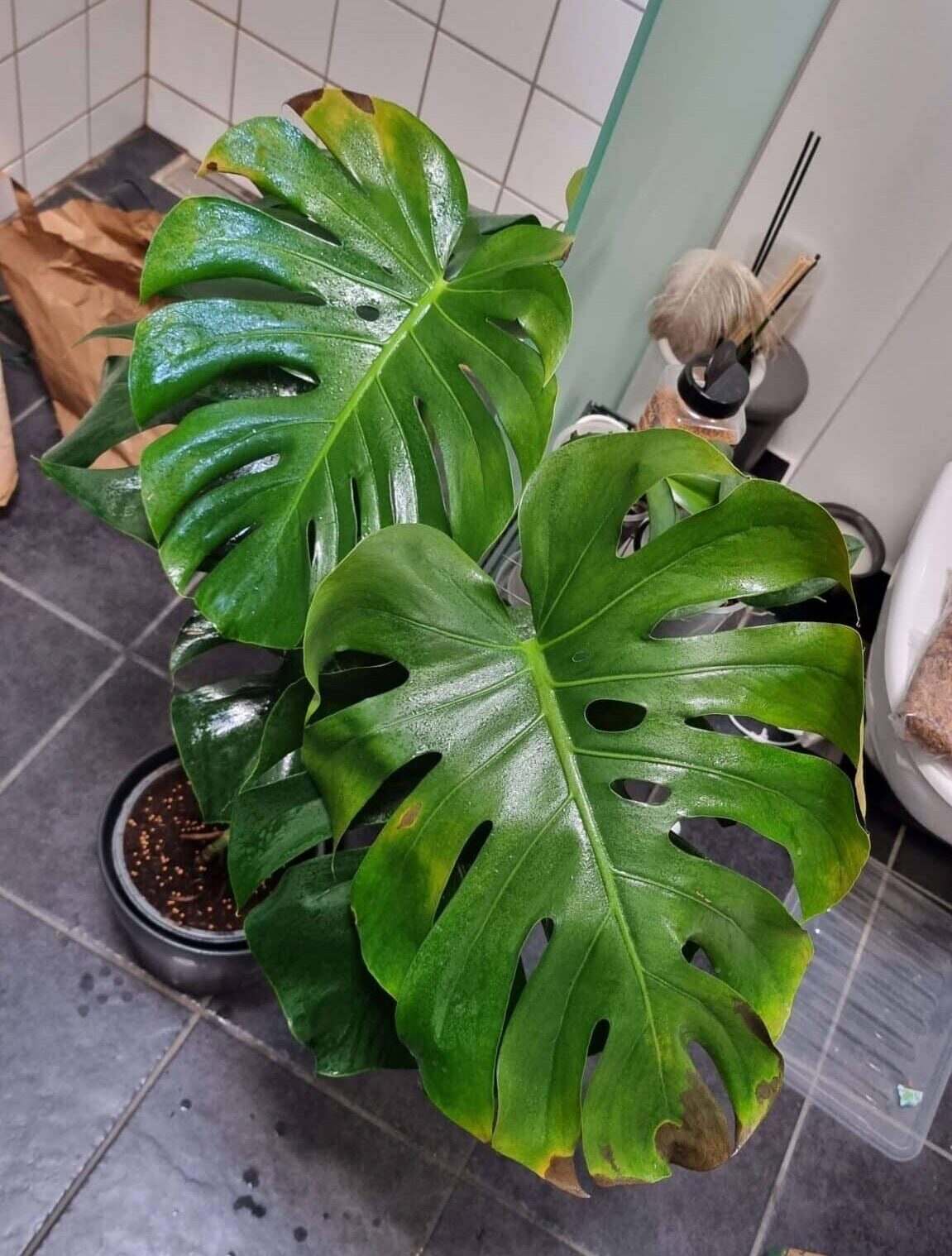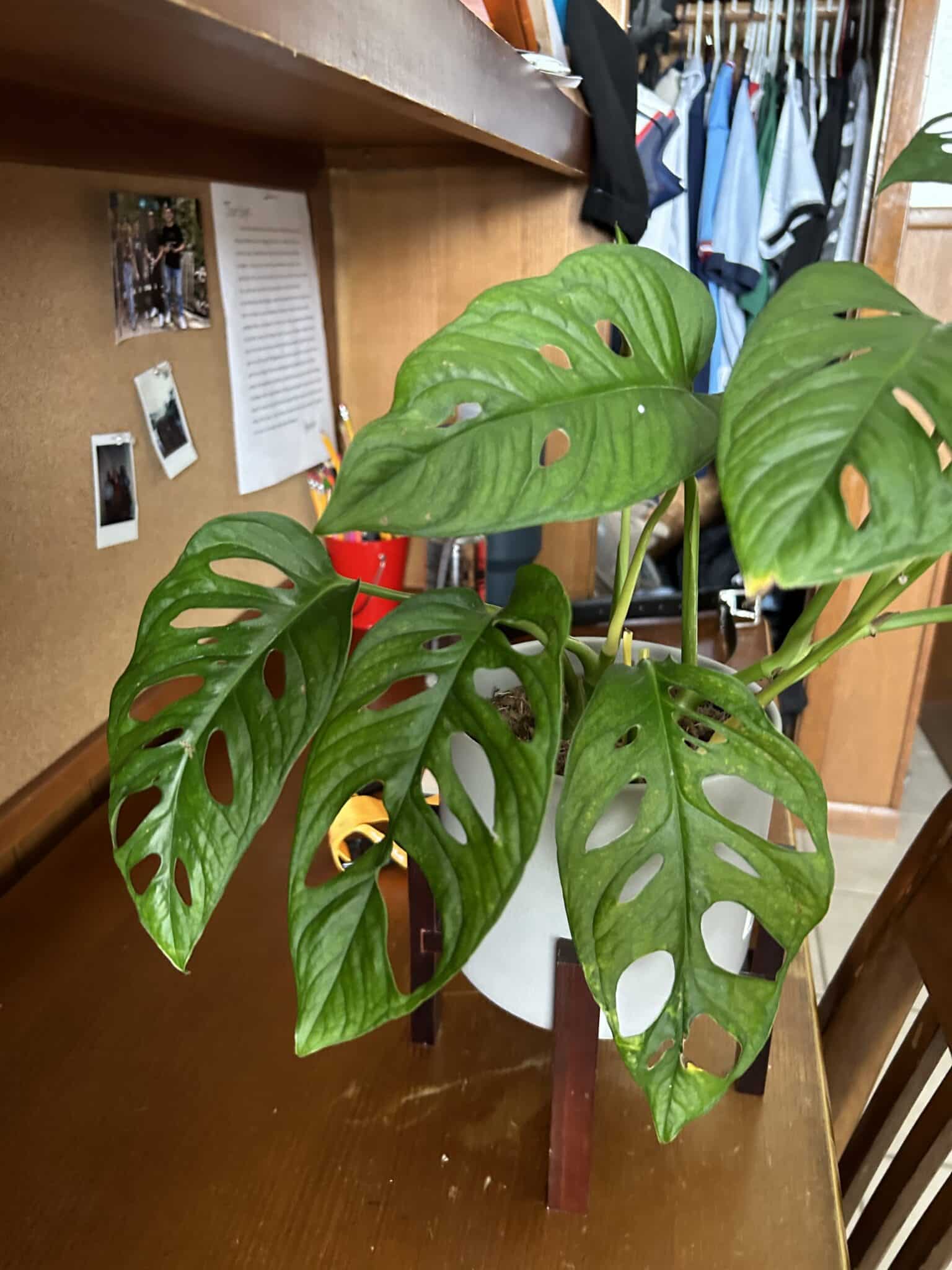I recently brought a beautiful Monstera home and kept it in the window, expecting to see a robust plant with signature heart-shaped leaves.
Alas! The leaves started wilting, changed colors, and turned crisp a few weeks later. The culprit was direct sunlight.
The scorching sunlight had severely dried my Monstera, but I was glad to know it could still be revived.

You heard it right! A sunburnt Monstera can be recovered and revived when minimal damage.
Read on to figure out what symptoms a sunburnt Monstera gives and how you can effectively treat them before the matter gets worse.
Table of Contents Show
Symptoms of Sunburnt Monstera Plant
Monstera is a magical Feng Shui plant that symbolizes long life, effectively traps dust, and cleanses indoor air until it remains vigorous.
The vigor is the first thing a sunburnt Monstera loses, along with the magical powers.
Hence, look for visible signs of a sunburnt Monstera so you can effectively treat it early.
1. Yellowing Leaves
Yellowing of the leaves is usually the first indication of sunburnt Monstera.
When exposed to direct sunlight or excessively high temperature, the soil will rapidly lose moisture. As a result, the plant will start losing water through transpiration.

It will absorb more water to compensate for the loss, causing increased evaporation and surplus moisture loss.
The drying leaves will begin yellowing, starting from the leaf base and gradually taking over the entire leaf.
However, many other problems could cause yellowing foliage, too; hence, you should always diagnose the problem.
- Check whether you have placed it too close to a window or door that receives direct sunlight
- Inspect whether the wall or glass is reflecting the sunlight towards the plant.
- If the weather is arid and the temperature is soaring above 90 degrees Fahrenheit.
If all the above match, you should know the yellowing is caused by direct sunlight.
2. Burn Spots on leaves
Brown spots, referred to as burn spots, are commonly found on sunburnt Monstera leaves.
Partial shade plants need at least 15,000 lux of sunlight to grow without burning; however, the full sun may give over 100,000 lux of light that severely burns the shade plant.

The intense direct sunlight can severely damage the tissues found on softer foliage, where prolonged exposure to sunlight creates burned spots.
The spots may appear dead, eventually creating holes in the leaves.
Look out for tan or light gray spots to catch the problem early. They frequently appear on top leaves that are closer to the light source.
Soon after the leaf starts tanning, the browning will appear until you immediately treat it, which is more prevalent in late spring or summer when the temperature rises exponentially.
3. Tips and Edges Turning Browm
Another early indication of sunburnt Monstera is browning tips and edges.
When a plant is not used to getting direct sunlight, it will start losing significant moisture due to transpiration and respiration. Evaporation from the soil and leaf surfaces may worsen the problem.
As a result, moisture-less Monstera will begin browning in parts that are severely dry, such as leaf edges and tips.
The browned tips and edges will feel brittle, dry, and crunchy to the touch.
4. Brown or White Foliage
A more severely sunburnt Monstera will exhibit brown or white foliage; however, it may take a while to witness this symptom.
The discoloration may begin with some pailing after the burn. As they advance, the paling will become more prominent.

When the plant is not used to direct sun exposure, such as Monstera, the bright light may affect chlorophyll production through photosynthesis, causing rapid deterioration.
The drying foliage will turn crispy and washed out in no time, leading to a whitening or silver-gray presence.
It indicates the plant has been exposed to the sun for too long.
5. Wilted and Droopy Leaves
Wilting and drooping leaves may indicate a sunburnt plant; however, it is often accompanied by a dry, browned, or crispy texture.
The Monstera will begin wilting and drooping when exposed to harsh sunlight. It will suck the moisture out of the plant, including its leaves, causing excess transpiration.

Check for stem dieback signs, such as decayed lower stems which usually follow wilting.
Drooping leaves are an indication of an overwatered plant as well. Be wary about diagnosing the overwatering problem before concluding otherwise.
6. Crisp Leaves
The scorched Monstera leaves will usually turn crispy when they die.
The fatal combination of severe dehydration and sunburn will encourage dried leaf margins, causing premature crisping.
A temperature above 95°F will quickly eliminate humidity from the air, leading to dried and crispy leaves.
Crisping will usually begin at the top surfaces of leaves closest to the light source and then continue downwards.
The leaves may also curl up before turning brown around the edges, which gives early signs of leaf crisping.
How to Recover or Revive Sunburnt Monstera?
The best thing about the Monstera plant is that it responds to revival quickly and recovers well.
However, pay attention to severely damaged parts that are usually unrecoverable. Start with removing the damaged parts before proceeding towards revival.
Here are some proven ways to recover and revive sunburnt Monstera.
1. Relocate the Plant
Move your plant away from the direct light source to a shaded location.
For instance, if your plant is close to the west or south-facing window, move them at least 3-4” away.
Similarly, you can move them to the east-facing window that receives ample sunlight in the morning but less during the day.
Monstera is a shade plant that thrives under the shadow of large trees in the tropics. They require similar conditions at home to remain safe.
One way to achieve that is to place the plant at locations that receive plenty of bright, diffused sunlight, such as close to a curtained window, patio, or door.
However, refrain from placing them in low-light, damp areas that receive less to no sunlight.
2. Remove the Burnt Leaves
The next and most important thing to do is to recover the plant by cutting off damaged sections.
The damaged leaves will not heal anyway; however, they will take away the essential nutrients from the plant.
Therefore, get rid of damaged leaves to help revive the plant by channelizing the nutrients to healthy stems and young leaves.
Take a sanitized pruning shear or scissor and trim burned spots, browned or faded leaves, and spent or bleached leaves.
3. Moisten the Soil with Water
Watering is an effective way to revive a sunburnt Monstera that is left dehydrated.
Direct sunlight can damage plant tissue, resulting in significant moisture loss.
Hence, watering them will help the roots absorb and transfer moisture throughout the plant.
Tips to Revive Sunburnt Plants with Water
- Deepwater the plant and let the excess water flow out of the drainage hole. Don’t forget to empty the perched liquid saucer.
- Alternatively, soak the plant container in a bathtub or container with 3-4 inches of water for 45 minutes.
The latter method is more effective in reviving a dehydrated plant, allowing the soil to naturally absorb moisture from below.
To prevent further sunburns, water your Monstera frequently to help keep the soil slightly moist.
Otherwise, regularly mist the plant leaves in summer when temperatures soar above 90 degrees Fahrenheit.
4. Adequate Fertilizer
The Monstera that is severely distressed can be revived by fertilizing.
The fresh supply of macronutrients such as Nitrogen, phosphorus, potassium, and some trace minerals will help the plant attain its previous form.
However, ensure to apply fertilizer only during the growing seasons (spring and summer). Otherwise, wait until the winter has passed before fertilizing.
Ensure to dilute to half or 1/3 strength by mixing water before applying.
Similarly, ensure the solution does not touch the plant leaves and stem, further damaging the distressed plant.
5. Protect from Temperature Stress
Soaring temperatures are equally culprit to sunburnt plants.
Along with keeping from direct sunlight, ensure to protect your plant from severe temperature fluctuation.
Monstera plants prefer temperatures ranging from 60 to 85°F (15-29 °C), where anything above 95°F can suck the plant dry.
You can avoid this problem by bringing your plant inside when the temperature begins soaring, especially during late spring and summer.
- Regularly mist the plant leaves, especially in the morning.
- Frequently water the plant every 3-4 days during summer when the temperature goes above 95°F.
- Alternatively, place the plant in a pebble tray filled with water to maintain moisture and humidity.
However, prevent the plant from sitting below 55°F (13°C); it may invite cold stress.
Move the plant under the appropriate LED grow light inside the house and add a layer of insulation to protect it from the cold.
Tips to Prevent Monstera from Sunburn
Here are some proven tips to prevent sunburn.
1. Use Sunblock
If you cannot provide optimum shade to your Monstera, applying Sunblock may help prevent moisture from escaping the plant.
Adding a layer of mulch over the potting mix helps protect your plant by absorbing the sunlight before it reaches the soil.
It may also help maintain an ideal soil temperature.
2. Create a Shade
If you cannot move your plant inside, consider creating a shade netting or tent-style covering to prevent exposure to direct sunlight.
Alternatively, a shade screen will help protect from sunlight, wind, rain, and other elements.

Window providing bright indirect light would be optimum for your Monstera.
Use a sheer curtain or UV-blocking film for some shade. If your room receives more than enough saturated light, thin drapes can help minimize it while allowing enough for healthy growth.
3. Harden your Monstera
There is a higher chance of sunburn in recently awakened (from Dormancy) Monstera.
Therefore, it is best to slowly expose plants to light in late winter and early spring rather than suddenly moving them to a sunnier location. Gradually changing locations will help your Monstera to harden itself.
This will allow them to adapt and acclimate and reduce the risk of sunburn.
If at home, start at the furthest point from the house. Then gradually move it toward a window illuminated by bright indirect light.
Applying fertilizer in the early spring can also be helpful. It will make the plant ready for new growth earlier.
Whereas Fertilizing in the scorching summer will promote new growth in the summer, and those new, dedicated foliage are likely to get Sunburnt Sooner
Tips: Balanced half-strength liquid fertilizer per month in the growing season. Be Aware- fertilizers can cause water stress in your Monstera
Conclusion
Monstera is too picky about the growing condition, where it requires a warm temperature around the year to thrive.
However, exposing them to direct sunlight to compensate for low temperatures will have the opposite effect.
Instead, place them close to the light source but not without shade to prevent sunburn.
